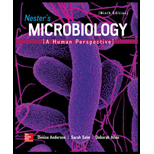
Concept explainers
How do lactobacilli help protect the vagina from potential pathogens?
To review:
The way lactobacilli aid to protect the vagina from the pathogens.
Introduction:
Lactobacillus refers to the genus of the bacteria, which is facultatively anaerobic and Gram-positive and along with this it is rod-shaped and nonspore forming bacteria. These are also known to be the prime part of the lactic acid bacteria club and in humans, they contribute the significant element of the microbiota at different sites of the body.
Explanation of Solution
Vaginal flora or also known as vaginal microbiota refers to the microorganisms thatcolonize the vagina and they were found in the year of 1892. The type and the number of bacteria present consists of significant implications for the woman’s overall health and the primary colonizing bacteria present in the healthy individual refer to the genus called Lactobacillus. Thesebacteria produce lactic acid in the vagina and protect the vagina from infection of pathogenic species. The pH (potential of hydrogen) of this is low and it is accepted by the prime mechanism that controls the composition of the vaginal microflora.
Therefore, it can be concluded that the lactobacilli produce the lactic acid in the body, which prevents the vagina from infections.
Want to see more full solutions like this?
Chapter 27 Solutions
Nester's Microbiology: A Human Perspective
- Explain how the hormones of the glands listed below travel around the body to target organs and tissues : Pituitary gland Hypothalamus Thyroid Parathyroid Adrenal Pineal Pancreas(islets of langerhans) Gonads (testes and ovaries) Placentaarrow_forwardWhat are the functions of the hormones produced in the glands listed below: Pituitary gland Hypothalamus Thyroid Parathyroid Adrenal Pineal Pancreas(islets of langerhans) Gonads (testes and ovaries) Placentaarrow_forwardDescribe the hormones produced in the glands listed below: Pituitary gland Hypothalamus Thyroid Parathyroid Adrenal Pineal Pancreas(islets of langerhans) Gonads (testes and ovaries) Placentaarrow_forward
- Please help me calculate drug dosage from the following information: Patient weight: 35 pounds, so 15.9 kilograms (got this by dividing 35 pounds by 2.2 kilograms) Drug dose: 0.05mg/kg Drug concentration: 2mg/mLarrow_forwardA 25-year-old woman presents to the emergency department with a 2-day history of fever, chills, severe headache, and confusion. She recently returned from a trip to sub-Saharan Africa, where she did not take malaria prophylaxis. On examination, she is febrile (39.8°C/103.6°F) and hypotensive. Laboratory studies reveal hemoglobin of 8.0 g/dL, platelet count of 50,000/μL, and evidence of hemoglobinuria. A peripheral blood smear shows ring forms and banana-shaped gametocytes. Which of the following Plasmodium species is most likely responsible for her severe symptoms? A. Plasmodium vivax B. Plasmodium ovale C. Plasmodium malariae D. Plasmodium falciparumarrow_forwardStandard Concentration (caffeine) mg/L Absorbance Reading 10 0.322 20 0.697 40 1.535 60 2.520 80 3.100arrow_forward
- please draw in the answers, thank youarrow_forwarda. On this first grid, assume that the DNA and RNA templates are read left to right. DNA DNA mRNA codon tRNA anticodon polypeptide _strand strand C с A T G A U G C A TRP b. Now do this AGAIN assuming that the DNA and RNA templates are read right to left. DNA DNA strand strand C mRNA codon tRNA anticodon polypeptide 0 A T G A U G с A TRParrow_forwardplease answer all question below with the following answer choice, thank you!arrow_forward
- Understanding Health Insurance: A Guide to Billin...Health & NutritionISBN:9781337679480Author:GREENPublisher:Cengage





